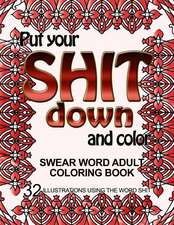Reportage Illustration: Visual Journalism
Autor Reportage Drawing Gary Embury, Reportage Drawing Mario Minichielloen Limba Engleză Paperback – 10 ian 2018
Preț: 198.06 lei
Preț vechi: 226.68 lei
-13% Nou
Puncte Express: 297
Preț estimativ în valută:
37.91€ • 39.07$ • 32.00£
37.91€ • 39.07$ • 32.00£
Carte disponibilă
Livrare economică 10-24 februarie
Livrare express 24-30 ianuarie pentru 68.49 lei
Preluare comenzi: 021 569.72.76
Specificații
ISBN-13: 9781474224598
ISBN-10: 1474224598
Pagini: 176
Ilustrații: 200 colour illus
Dimensiuni: 210 x 270 x 16 mm
Greutate: 0.68 kg
Editura: Bloomsbury Publishing
Colecția Bloomsbury Visual Arts
Locul publicării:London, United Kingdom
ISBN-10: 1474224598
Pagini: 176
Ilustrații: 200 colour illus
Dimensiuni: 210 x 270 x 16 mm
Greutate: 0.68 kg
Editura: Bloomsbury Publishing
Colecția Bloomsbury Visual Arts
Locul publicării:London, United Kingdom
Caracteristici
Written by two reportage artists and educators who have worked in the field for The Guardian, The Daily Telegraph, New Scientist, The Economist and BBC News.
Notă biografică
Gary Embury is a senior lecturer at the University of the West of England, Bristol and an illustrator with over 20 years of experience. Clients include The Guardian, The Daily Telegraph, Radio Times, Aardman Animations, BBC, BritishTelecom, Barclays Bank, The Economist, New Scientist, The Sunday Times Review, Sunday Times Magazine, Microsoft, Penguin Books, Macmillan, and many other advertising, editorial and publishing clients. Awarded Gold, in Images 30, The Best of British Contemporary Illustration 2006 and took part in a discussion on Radio 4's Front Row program hosted by Kirsty Lang on the future of illustration in the digital age. He is the editor of which showcases and initiates projects in the area of drawn reportage. Mario Minichiello is a Professor at the School of Design Communication and IT at Newcastle University, Australia. He is also Head of the Hunter Centre for Creative Industries and Technology as well as the author of The Art of Conflict, which contains his reportage drawings during his assignment in the Afghanistan war.Over the past fifteen years, alongside his academic career, he has worked as an Illustrator, primarily in the field of national and international broadcast and broadsheet media. His reportage illustration work for BBC Newsnight formed part of their BAFTA Award for news and current affairs. Among the events he covered during the late 1980's included the Birmingham Six hearing, Beirut hostage releases and Spy Catcher trials. His work has also appeared in The Guardian and Financial Times
Cuprins
Chapter 1: What is Reportage DrawingBackgroundThe rise of reportage and the influence of the war artistThe camera and the eyeCase study: George Butler/SyriaInterview: Jill GibbonChapter 2: Materials, Media and MethodsChoosing the right materialsTechnology and digital mediaCase Study: Jenny Soep/ Capturing a live eventExercise: Drawing a live eventBox: Checklist of materialsInterview: Julia MidgleyInterview: Tim VynerChapter 3: Developing a Visual LanguageIndividual approachesCase Study: Jedidiah Dore/New York CityCase Study: Sue Coe/Elephant Nature ParkExercise: Developing your visual languageInterview: First Hand Reportage CollectiveInterview: Olivier KuglerChapter 4: On Location Beginning a projectCase Study: Gary Embury/ The Bristol Bike ProjectInterview: Lucinda RogersInterview: Jenny SoepChapter 5: Capturing a sense of placeCase Study: Veronica Lawler/Mystic SeaportChecklistTips and techniques: On locationCase Study: Luisa Crosbie/ Her Majesty's Theatre, LondonCase Study: Anne Howeson/ Drawing and MemoryInterview: Bo SoremskyChapter 6: Creating a NarrativeDeveloping the storyStory selection and developing content Tips and techniquesOutlining your storyInterview: Louis NetterInterview: Chloe ReganExercise: Creating a story using a fixed viewpointChapter 7: Becoming a Visual JournalistCreating a digital portfolioTips in preparing your portfolioEditing your portfolioThe world of workFinding workSpeculative workWorking through a galleryDirect calling and arranging interviewsResponsibilitiesHuman ethics and professional practice Tips and checklistsCase Study: Mario Minichiello/Weekend Financial TimesExercise: Developing a reportage illustration briefConclusionThe future of reportageInterview: Martin HarrisonContactsCreditsIndex
Recenzii
Whether using sketchbook and pencil or adding online animation and interactive elements, the possibilities will excite illustrators who can work quickly in public and have something to say.
Offers practical advice on the nitty-gritty of becoming a professional ... [The authors have] pulled together a great bunch of artists to feature in the book ... The book is excellent in encouraging readers to continue to experiment and explore, even when they may have found their own hard-won visual language ... This is a book that challenges us to confront what we are saying in our work and how we are saying it.
Interest in reportage keeps growing, and this book is a great primer on the subject ... Authors Gary Embury and Mario Minichiello are practitioners and educators ... and they bring clear information and an enthusiasm for their subject which is infectious ... The book provides plenty of examples of riveting work and a strong argument for the power of illustration as a witness and recorder of events through first hand observation.
Offers practical advice on the nitty-gritty of becoming a professional ... [The authors have] pulled together a great bunch of artists to feature in the book ... The book is excellent in encouraging readers to continue to experiment and explore, even when they may have found their own hard-won visual language ... This is a book that challenges us to confront what we are saying in our work and how we are saying it.
Interest in reportage keeps growing, and this book is a great primer on the subject ... Authors Gary Embury and Mario Minichiello are practitioners and educators ... and they bring clear information and an enthusiasm for their subject which is infectious ... The book provides plenty of examples of riveting work and a strong argument for the power of illustration as a witness and recorder of events through first hand observation.















